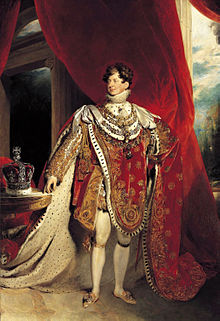Coronation crown of George IV of Great Britain
The coronation crown of George IV , King of Great Britain from 1820 to 1830, was commissioned for his coronation . It consists of gold and silver , several thousand diamonds , pearls and other precious stones. It is 37.4 cm high and has a diameter of 18 cm to 20.8 cm.
The broad, openwork coronet bears rows of pearls on the upper and lower edge. On the circlet there is a silver ornament made of rose petals, buds and tendrils with diamonds of different sizes. A flat wavy band, decorated with diamonds, sits above the ring. Four crosses and four lilies rise up from the tops of the waves. The lilies are taller than the almost square crosses. The crosses are set in diamonds and emeralds , and on the lilies are diamonds and rubies . The four temples rise from the crosses like volutes. They are adorned with an ornament made of diamond oak leaves and pearls as acorns. At the apex of the temple there is a globe with a cross. The cross has the same shape as the one above the ring. Both are studded with diamonds. The crown hood is made of red velvet and extends to the top of the crown bracket.
The crown was made by order of George IV. In 1820 by the jeweler Rundell & Bridge, as the king preferred his own crown to the already existing one. Their shape and ornamentation formed the basis for the Imperial State Crown made in 1838 . Therefore their stones were removed and the carcass was kept in the London Museum, Kensington Palace . By DeBeers in the 20th century stones were rented worth £ 2 million. These are shown next to the crown carcass, which has since been exhibited in the Tower of London , to give visitors an idea of their original appearance.
literature
- Heinz Biehn : The crowns of Europe and their fate . Limes Verlag, Wiesbaden 1957.
